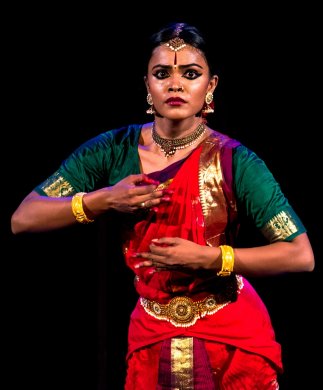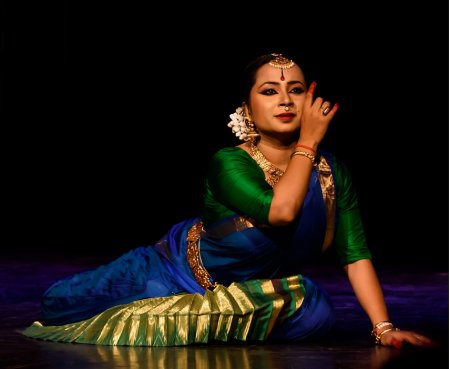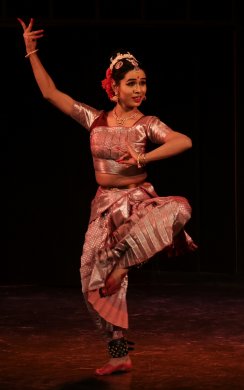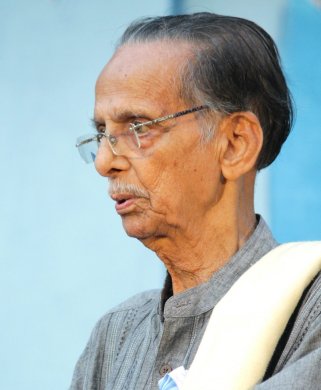
|   |

|   |
 e-mail: leelakaverivenkat@gmail.com Dance in Delhi after the Pandemic August 2, 2022 The first live stage performance this critic was experiencing after a two year pandemic lock was at the Habitat auditorium, featuring a Bharatanatyam recital by Sudhana Sankar, a long time student of Saroja Vaidyanathan, who however, with the Guru not in the best of health, has very recently come under the grooming of the successor and next in family line, Rama Vaidyanathan. Apart from the enthusiastic response from a packed hall, the evening presented a dancer who has worked sincerely on the movement technique of Bharatanatyam as taught to her. A word of caution however, for one who would seem to be at the training crossroads - for before fully finding herself, she has had to come under a different, very strong performer teacher (from all accounts painstaking too) whose style she, knowingly or unconsciously (an oft seen factor) is prone to imitate. Learning from the teacher has to go hand in hand with trying to find one's own self in the dance.  Sudhana Sankar The program, comprising items largely choreographed by Rama, began with a salutation to the Himalayas, based on Kalidasa's famous poetry in the Kumara Sambhavam in the oft quoted lines: Astutyarasyaam dishi devadaaatma Himalayonaama Nagaadhirajaha Poorvaaparau toyanidhi vaghaahya Sthitavprithivyaam ivamaanadandaha The poet's imagination likens the mighty mountains stretching from the east to the western seas, to Earth's measuring rod. With Vasudeva Iyengar's music in Kalyani, Rama's compositional interpretation, with the visualization also portraying the flora and fauna of the mountainous terrain, in the sahitya as well as in the nritta interludes, aspires to evoke an image of the immeasurable wonder of this mountain. While Sudhana injected a certain emphasis into the pure dance, the overall expressional statement of adbhuta (astounding wonder) needed greater articulation. Rama's choreography delights in the surprise element of fractional intervals of tala, in both nritta and the sung line, highlighted through touches like sudden percussion punctuations. For the less experienced dancer, this can however induce a restlessness interfering with the mimetic concentration, as seemed to be the case in the varnam in Bhairavi "Mohamana en meedu". Here the emotional demands on the dancer lie in the lovelorn nayika's three statements in different tones starting with chiding the god Tyagaraja (modi seyyalamo en swamy) for not responding to her call, and then going on to being overwhelmed by admiration for Lord Brihadeeshwara residing in the temple town (Tirunagaril vaazhum), and in the final statement "Bhoga Tyagesa anubhogam seyya vaa", offering herself body and soul to the Lord - with the erotic running, as is usual in most varnam compositions, alongside the deeply spiritual (sringar bhakti). Aesthetic relief and beauty are in the contrast of lively teermanams coming after the internalized quietude of the abhinaya sections. The dancer however came into her spirited own in the charanam line of the varnam, wherein the smitten nayika chides Manmatha for his attack with his myriad flowered darts. The episode of the shaming of Draupadi in the Mahabharata, seen against the treatment of women down the ages, has acquired an ever contemporary ring, which young dancers are wont to respond to with passion. And so it was with Sudhana, with the final statement that woman today, much like Draupadi, let down by five great princes she was wedded to, with all the Kaurava brothers, elders like Shakuni, Dhridharashtra, and Gandhari not coming to her rescue, has to fight for her place, and not depend on the other half to guard her. The dancer performed to music in Darbari Kanada comprising the one line "Draupadi ki laaj rakhi…" (sung in the manner M.S Subbulakshmi made so well known) with involvement. In the other interpretative offer, one missed the quality of silence which has to go with a delicate composition like "Teruvil varano, ennai satru tirumbi paaraano.." in Kamas. Full of a nostalgic tenderness, the song expresses the deep yearning of a lovelorn nayika "If only, if only, the Lord (in procession), would turn his head but once to throw a glance at me." It has been interpreted variously as expressing the lovelorn maiden's longing for a glance, and also as narrating an event in the past. Either way, the dancer's abhinaya was a bit strident, puncturing the softness needed - and the spaces for bhava soaked Kamas music by vocalist Sudha too got lost. What Sudhana is able to achieve with her potential should be reassessed after a full year or more under her present teacher. ARTS AND RESONANCE  Swarnali Kundu (Photo: Rahul Naag) Nadasutra Arts and Resonance, a performing arts centre based out of New Delhi, presented yet another evening of dance, with rains playing spoilsport, at the Stein Auditorium under the title of Ananta (The Unconstrained). Akash Mallick (Artistic Director), Swarnali Kundu, a dancer who completed her M.A in Bharatanatyam from Rabindra Bharati University, and Kuchipudi dancer Amrita Singh who received training under late Dr. Sobha Naidu, work with the stated aim of 'taking Indian art to a larger audience in a comprehensive and yet contemporary presentation.' In what seemed the usual type of performance, the rain gods played spoil sport, resulting in a scanty audience. And why try, through words to define an indefinable word like Ananta (The unconstrained)? Does not all art aim at touching that space and state-of-being, not open to experience in mundane daily life? In a program based entirely on recorded music, Swarnali Kundu's footsteps despite the ankle bells, overpowered by the decibel level of the music and percussion ( poor sound balancing adding to the malaise), went totally unheard, despite a strong movement profile, wherein the choreography showed more of the chauka than the ardhamandali. The Poorvi Tillana suffered the same fate of footwork not heard. The best in the dancer came out in the Gita Govindam Ashtapadi "Kuru Yadunandana" expressing Radha's languorous demand that Krishna repair the dishabille of after-love on her person, (representing her renewed desire for sringar lila, with her independent identity - lost in the oneness with Krishna restored). In an item taught to her by Priyadarsini Govind, to have sustained the erotic address, in a seated position right through, with just the torso and hand movements evoking the expressional message, speaks creditably of both the teacher and the taught.  Amrita Singh The second dancer of the evening, Amrita Singh has emerged as one of Dr.Sobha Naidu's finest students. Slim as a wand, the Kuchipudi grace, as she moves over the stage is very reminiscent of her guru in her younger days as the most acclaimed student of Dr.Vempati Chinna Satyam. Marakata manimaya chela with the very detailed and prolonged Krishna-Sudhama encounter , was performed with involvement and no hint of fatigue. The finale "Kanaka manimaya noorpura rachana" with the Tarangam virtuosity with feet balanced on the rim of a brass plate, was rendered effortlessly. The head dress with the flower veni getting loose, and occasional frozen stances not quite in line with the classical Kuchipudi profile were the two points to look into - in what was a very fine dance effort. More preparatory interaction with the compere for the evening, very confident otherwise, would have avoided fumbling on basic terms like Natesa Kavutvam. A brief one minute written script on the specific place and mood of the chosen Ashtapadi would have helped in a work where sringar is the common note, but with each Ashtapadi pivotal to a special situation in the Radha-Krishna dialogue. SNA'S HOMAGE TO KAVALAM NARAYANA PANIKKAR  Kavalam Narayana Panikkar At Rabindra Bhavan's Meghdoot 3 auditorium, the Central Sangeet Natak Akademi held a special event as homage to late Kavalam Narayana Panikkar - 'A National Treasure' as he has been referred to. Befitting the occasion, the Akademi released a special issue of its journal Sangeet Natak of two sizeable volumes, comprising articles on Kavalam Narayana Panikkar - covering all aspects of this prodigiously talented thespian. With Ankur Acharya as editor and Chavan Pramod Junior as guest editor, the massive issue covers K.N. Panikkar's contribution to theatre, to music including his creations for films, to poetry and to Mohiniattam dance in particular. His many interactions with theatre persons and his own ideas show strong belief anchored in the regional background - but which, as a cog in the time /space continuum, absorbed into its identity layers converging aspects of Modern/Post Modern and Traditional Theatre. His ideas on acting style and training methodology and his thought processes on "Agriculture to Culture and Culture is the Body' and above all the simplicity of a man on whom greatness sat so lightly, are all part of the two volumes. Regionalism in Kerala did not discard Sanskritisation. Instead it localized the national tradition- as for example in its creation of manipravalam. Kavalam's contribution to Mohiniattam (Mohiniyattam as it is spelt in these volumes) put the dance form on an entirely new footing, after its early revival by Swati Tirunal, who along with Vadivelu of 'Tanjai Nalwar' fame influenced a great deal of the music. The dance form got established with Mahakavi Vallathol Narayanan's patronage, at Kerala Kalamandalam. With Kavalam's total belief in the identity of an art form interred in the soil and being expressed in its folk arts, and of regionalism as part of the collective national psyche, Mohiniattam was for him the organic outcomeof a woman centric culture starting with traditions like Nangyar Koothu, and the Bhagavati worship of Kerala with expressions like Mudiyettu and Kalamezhuthu. For him, Mohiniattam being rendered to Carnatic classical music totally distorted its identity. On the other hand, being rendered to Sopanam music suited the circular geometry of its body movement. Sopanam's Aakara / Kattala svaras complimented the andholika, chuzhippu of torso of Mohiniattam and going with the kinetic need, Kavalam relied on the vaitaris based on the percussion of edakka, the toppi maddalam and chengila. Equally important in the phonetics, the Sabda and Ashabda (sound and non sound intervals) in the rhythm patterns had a dramatic quality and musicality which balanced the time/space relationships of the body language. Not only did it elevate the feminine grace, but it also gave the dance form the ability to accommodate other characters, outside the conventional. With his genius for ideas and substantiating them with lyrics and music composed by him (with dance composed by the dancers), Kavalam created a whole new repertoire for Mohiniattam, investing it with a totally indigenous identity. Apart from nritta items built round the movement patterns in a Cholkettu Mukhachalam, Tatvam, Jiva were the interpretative items like Ganapathy Stuti, Thyani/Padangal, not forgetting lyrics and music arrangement he did for dancer Kanak Rele's compositions like Gandhari, Kubja and innumerable other creations. Kutcheri style Mohiniattam became Seva style Mohiniattam. With all his insistence on the identity of the music for the dance form, Kavalam never restricted scope for expression of the dancer's improvisational impulses. The combined lata (uncoiling) and jata (coiling), the energy patterns formed by the andolitam (undulating), sphruttam and kampitam with the circular energy patterns of the torso movements, evoked a tantric transformative strength like the rising of the Kundalini Shakti, which Kavalam Narayana Panikkar believed in. After the formalities of the evening's announcing the release of the two volumes (a most timely and fitting tribute for a redoubtable contributor to the field of total theatre) the evening ended with a presentation of Naga Tatvam, the master's lyric and music with dance in the Mohiniattam form by Jayaprabha Menon. Set to Punnagavarali and adi talam (with a brief khandam 'takatakita' interlude, the paucity of sahitya in the typical Narayana Panikkar vein, (vak or written word in his case had a dhwani) with a lot of scope for choreographic creativity, was well handled by Jayaprabha and her troupe. The repetitive body kinetic by the group with the andolika, in an accelrado of "Aadu Pambe" evoked a feel of coils of spiraling energy winding upwards. The dancer has included a brief ardhanari at the end which was a contrast in mood. One expected more of the Mohiniattam brigade which was missing, to grace the evening. One was particularly surprised at the absence of dancer Bharati Shivaji, one of the earliest (aside from Kanak Rele) to have had the benefit of direct instruction from Kavalam and whose dance presentations had an enormous impact on the Mohiniattam scene. I still remember her demonstrating the silent and verbalized part of Marma Talam!  Writing on the dance scene for the last forty years, Leela Venkataraman's incisive comments on performances of all dance forms, participation in dance discussions both in India and abroad, and as a regular contributor to Hindu Friday Review, journals like Sruti and Nartanam, makes her voice respected for its balanced critiquing. She is the author of several books like Indian Classical dance: Tradition in Transition, Classical Dance in India and Indian Classical dance: The Renaissance and Beyond. Post your comments Pl provide your name and email id along with your comment. All appropriate comments posted with name and email id in the blog will also be featured in the site. |